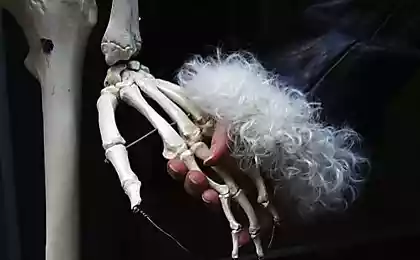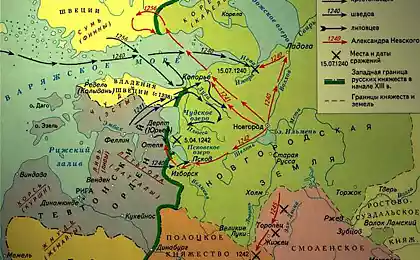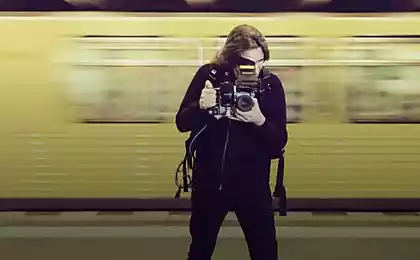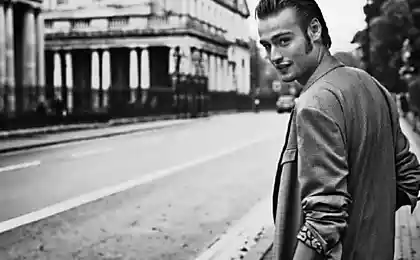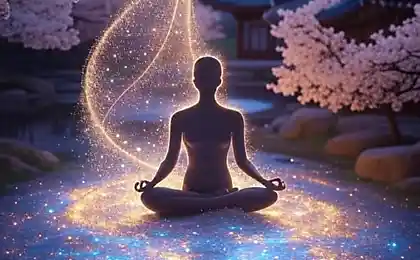1135
Vađđamaa (Vod) - the last moments of history.
10 photo + an interesting article.
My Thanks! Auto RU.
There are people, great for its history and culture, and there are people who have been great. There are peoples whose past and future exist, and there are people who have left just past. And speaking of Bodi, is to talk about the past ...
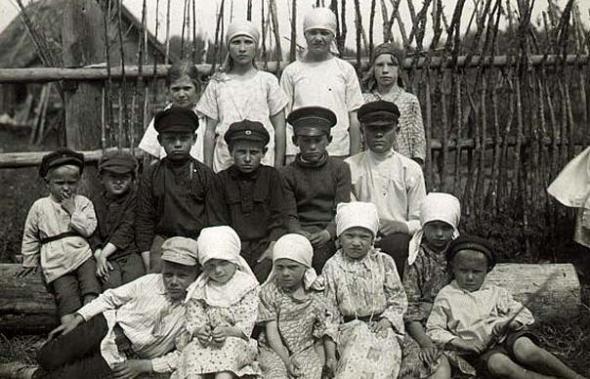
Ancient history.
Few people know that Vod, along with Izhora - the oldest known to us the people of the North-West of Russia. Historical information about Vod is very scarce and refer only to the period of the Middle Ages, though perhaps ancient reports of "Chud" relate to this small ethnic group. Since Vod lived on the outskirts of Novgorod possessions, Russian chronicles evade its history in silence, noticing only the most visible - a disaster and war.
Found sickles, scythes, and millstones in medieval cemeteries Vod say that the main occupation of the people already in those days was agriculture. It made it possible to keep nourishing life, but periodically imposes a heavy tribute - crop failures and famine. Annals of scarce emotions. But how terrible were the consequences of the famine in 1215, when the hand of a monk usually reserved subscribed to these news letters and jagged lines. People eat pine bark, lime leaves and moss. The poorest gave their children to others, so that at least they may be saved from starvation. Deaths were nadorogah, boxes and shopping areas - and they were so numerous that it was impossible to bury. "Vaujany pomrosha and ostanke razidesya».
Sources of Vod known from the second millennium since the people did not know writing. Carriers Culture letters were Slavs who appear on these lands in the IX-X centuries.
The appearance of the Slavs in the lands of Vod is primarily due to the fact that at the end of the XIII century on the Neva was laid Volga trade route, and along the rivers Luga and Mshage Shelon - second trade route.
The fertile soil of the Izhora Plateau has attracted a lot of Slavic immigrants who settled intermingled with the indigenous inhabitants.
At the beginning of the second millennium Vod was independent from Novgorod people. This is evidenced by the first mention in Russian written document - the charter of Yaroslav. The source said about the campaign in 1069 Polotsk prince Vseslav to Novgorod. His army largely consisted of Vozha River (Vod). The prince was defeated, lots Vozha River died.
In the first half of the XII century the influence of Novgorod increases. The interest of the Russian state is due primarily to the fact that Votskaya land (land Vod) was of great strategic importance. The presence of allied relations between vodyu and Novgorod confirmed the Novgorod First Chronicle. In 1149, the Finnish tribe Em went on a campaign Vod, but Novgorod helped detachment, numbering 500 soldiers. Allies routed the invaders, from which few escaped.
By this time the mention of the Novgorod region - fifths that make up the territory of the Novgorod state. One of fifths, located on the southern shore of the Gulf, ie Vod in the territory called Votskoy. Consequently, in the middle of the XII century Vod is part of Novgorod.
Since the second half of the XII century in the Baltic region appear powerful contenders for the land - Western Knights and begin a consistent winning. Between 1164 and 1181 years, held the bull (edict) Pope Alexander III to the Swedish Bishop Stefan. Swedish alleged impact on votlandtsev (Vod). This is the first mention of the Vod in foreign sources.

Pope Alexander III.
In 1202, militant Knights formed the Order of the Sword. Already in 1224 the invaders take possession of the ancient Russian city of Yuriev (Tartu). Now it is possible to direct threat Pskov and Novgorod principalities, especially that both countries plagued internal conflicts. In 1228, for example, concluded a treaty with the people of Pskov and the Order invited the German squad, which helped get rid of unwanted Prince Yaroslav. But the tireless Prince sat in Novgorod and made seven campaigns against the Germans, Lithuanians and Swedes.
Apparently, the Vod has a substantial military support to Novgorod, as in 1230, Pope Gregory IX had to prescribe a Swedish archbishop to forbid all Christians carry the Gentiles votlandtsam weapons, iron and wooden products, "That faith of Christ has not been Iskor Her enemies".
In 1237 followed by a new bull of the pope, in which he tells him to make an appeal for a crusade against the pagans and their allies Russian. But the people of Novgorod were on guard, and in 1239 they undertook to strengthen the border, build a fortress on Shelon and resuming relations with Vodskaya ground.
July 15, 1240, Prince Alexander breaks detachment Swedish knights, led by Birger in the Battle of the Neva. Perhaps, along with the Finnish tribe Izhora, in the Novgorod army detachment includes Vod.

This painting done by St. Petersburg artist Igor Zhebrovsky to be installed in the future museum dedicated to the Battle of the Neva.
A month later, a small German and Danish knights led by the Vice-Master of the Order Andreas von Velvenom launched a major offensive in the Pskov and Novgorod. In winter 1240/41's capture followed Vodskaya territory and the laying tribute. However, Alexander Nevsky already in 1241 unexpectedly knocks invaders from Koporye and frees Vodskaya ground. Those people from Vozha River, which obviously kept the German side, he orders to hang. April 5, 1242 a battle took place on Lake Peipsi, which was won glorious victory over the Order. But the German attack continued until 1269, when concerned about a successful campaign of the Russian troops, they are asking for the world.
In the second half of the century XIII Vod is likely finally a part of Novgorod lands already mentioned. The reason for consolidation is firmly and included in the life of the peoples of both social and economic ties, and the constant threat from neighbors. Noticeable influence of Russian culture reflected in the funeral rite Vodskaya, which serves as the major identifier. In the XIII century the rite of cremation in stone fences replaced inhumation in groundwater wells, although both types of graves for some time coexist.
External threats in the XIV century unabated. In 1338, the Swedes attacked from Vyborg Vodskaya ground. But the defense was well organized and so the Swedes, "nothing is not vzyasha" were soon defeated the garrison of the fortress was. In 1348 the Swedish King Magnus with a great army invaded the Novgorod possession and began to baptize Vozha River. Some of them submits, but other organized resistance that was crushed by death squads. Soon, however, the Swedes go and traitors of Votes, like a hundred years ago, were hanged Novgorod.
Fortress Yam.
1384 was marked by building on the ancestral lands Vod fortress. Novgorod "postavisha stone town on the river Luga - Pit (Yam Yamburg Kingisepp-current)", indicating that a strong Russian influence on Vod. In 1397, the German squad attacked Vodskaya Pyatina and devastated neighborhood Pit. In the first half of the XV century, followed by a new attack by the Germans. In the 20's Master of the Order Finn repeatedly invades the Novgorod possession, burns a hole and capture many prisoners in Vodskaya earth.
In the war years 1444-1448 the Germans, united with the Swedes, together attacked Votskuyu fifths. Mentioned Germans capture many prisoners Vod that steal the Baltics and lodge near Bauska. It is interesting that local people called them krevingami (krievs - Russian).
By 1478, when the merger took place of Novgorod to the Moscow government, it should be noted some aspects of people's Vod. Contacts between Russian and vodyu are vzaimokulturny character. Vaujany generally retain the traditional culture with the exception of the funeral rite, which borrow from the Russian. Due to the fact that members of the hard-working people Votic actively manifest themselves in agriculture, trade and craft increases the value of land Vodskaya to score exceptionally strong pace of economic development in the part of Russia.

Nasty molbischa idolskie.
For the first time about paganism Vod we learn from written at the end of the XII century the message of Pope Alexander III, the first bishop of the Swedish city of Uppsala Stefan. And though in 1255 these lands Rome was appointed Catholic Bishop, Vod officially considered Orthodox. But the roots of paganism of the people were very strong. After three centuries, in 1534, Archbishop Makarios notified Novgorod Grand Duke Ivan that Vodskaya pyatina there are many idolatrous superstition, and that local people are still "bad molbischa idolskie." Pagans buried their dead not churchyard and on the mounds and "kolomischam" (from obschefinskogo word "Calma" - "world of the dead"), to the newborn called "Arbois" (priests). Vodskaya woman after marriage, shaved their heads and wore "deathly" clothing. Grand Duke ordered the "rotten ONU to eradicate": prayer grounds were destroyed, were cut and burned the sacred groves and trees, dumped into the water sacred stones, koldunov- "Arbois" sent to Novgorod to crack.
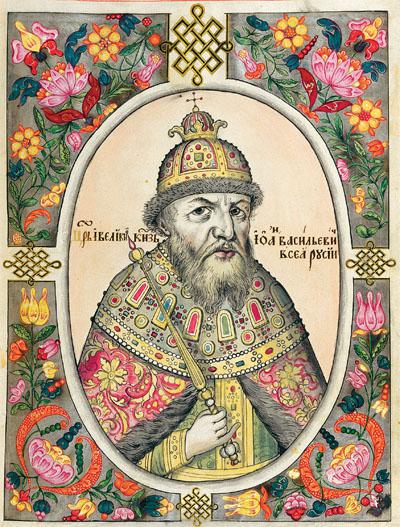
Ivan Vasilyevich (Ivan IV the Terrible)
But it is hard to find among the peoples of the North-West Russian population more fully keep their ancient beliefs and practices than Vod. Back in the mid-twentieth century Vaujany still worshiped the old trees, huge rocks, springs and wells. Even twenty years ago, arrived in Votic villages could get into a mysterious and forbidden world where everything was animate. Home and family defended the house, a guardian spirit was and livestock. Domestic spirits often approached people in the form of snakes - that is why snakes have always loved and lure. In the forest, has hosted the devil. His spirits had every rock, tree and flower. Spirits live in rivers, streams and swamps. To defend against them, you need to know hundreds of plots to come to terms with them, it was necessary to make sacrifices.
The shape and nature of Vozha River.
At first glance it is difficult to distinguish Vozha River among other Baltic and Finnish peoples. There are, however, two features have Vozha River. First, representatives of Vod only fair haired. Perhaps it was the fair-haired people in the world: 80% of men and 76% women's hair were white as snow turned yellow or golden like the sand.
We can not ignore another aspect of the external appearance of Votes, which is recognized by all the main, though it defies precise measurement. This is a beauty. At the end of the XVIII century a remarkable scholar of indigenous peoples Fedor Tumansky wrote: "Women chyudskie (Votic - DC) in general all are beautiful, have a cheerful, pleasant and attractive look, quick eyes, big blue ... they are of good growth, the hair almost all light-brown, have a healthy body, a gentle, white and clean ».
A famous Finnish historian portal regretfully admitted that women are much prettier Votic Finnish and Russian. Immediately struck by the nature and features: Vaujany seemed faster, lively and open towards other people than representatives of neighboring nations. In the XVIII century witnesses to notice such features Vozha River as "a very sharp mind, an early concept».
This natural alertness and manifest in language. Vodskaya speech was very lively. It is no accident at all was the answer to the riddle Vodskaya "Gudit-cracking the golden lock" (language). And the residents of the village on the river Luga Kurovitsy sometimes advised each other: "Tie language to your ear to talk less."
Votian.
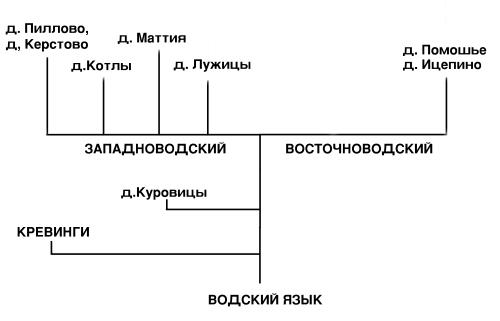
Votic language belongs to the Baltic-Finnish group of the Ural family of languages. Votian represented by several local dialects, which are usually divided into western and eastern. Among Western dialect etc. can be identified. Krokole close to him dialect villages Lusatia (Luutsa) and Sands (Liivcyla), dialects of the villages in the vicinity d Mattia (Mati), dialects of the villages in the vicinity d. Boilers (Kattila) and Dialects are sub- Boilers. To East Vodskaya dialects are several villages in the area Koporye (Kabrio). The difference between West and East Vodskaya Vodskaya dialects small.
By Votian traditionally carry two dialects, with significant differences from the above. This dialect krevingov, descendants Vodskaya prisoners resettled near Bauska Livonian knights in the middle. 15 in., And the dialect d. Kurovitsy (Kukkuzi), resulting from the "izhorizatsii" local Votian.
According to Paul Ariste (Estonian linguist) Vodskaya impact noted in some north-eastern dialects of Estonia and in some dialects in the Estonian shore of Lake Peipsi.
Vodskaya impact significantly in a number of Finnish dialects of Western Ingria.
Some researchers also mention the existence of a Baltic-Finnish near Gdov, Dobruchinskaya parish.
The first grammar Votian appeared in the 19th century (Alkvist). In the early 20th century, Dmitry Tsvetkov from the village. Krakolie Vodskaya wrote the first grammar of their native language. In the 30-ies., When creating scripts for minority languages to Votian not created a separate writing and learning in schools conducted at the Izhora language. Stalinist repression and Second World War caused great damage Vodskaya people. After the war, not all Vaujany was able to return to their villages. In schools in the postwar period teaching it was only in Russian, and the use of Votian not encouraged even in person. This has resulted in a sharp reduction in the spread of the territory Votian the end of the 20th century.
Nevertheless, since the beginning of the 90s. It begins a movement to revive Votian and in 1994 are beginning to function Votian courses in St. Petersburg. With the advent of the 21st century the activities of these courses is activated. At the same time begins the first time the teaching Votian high school d. Krakolie. Currently, work is underway to create a different kind of training manuals Votian.
Teach Votian (2.86 MB).
Clothing Vod.
Allocates Vod and unusual his clothes: without question you can immediately identify who walked past - a girl, pullets, older women or old.
Beautiful, but she was restrained maiden costume, it combined the two main colors - white and red. White hair and white clothes were supplemented by two red woolen bib crescent-shaped and the two red Gaiters' kaatyryd "hanging on the sides of the back. Adults girls their loose hair covered small cap incredibly beautiful, entirely embroidered with beads and bright tin plaques.
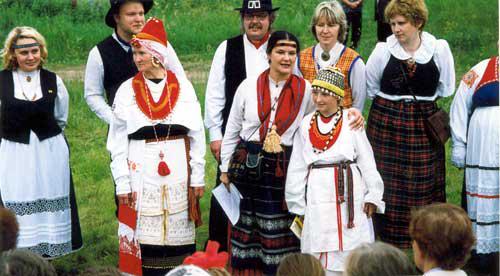
Votic costume of the late 18th century.
When a woman marries, her costume became bright and elegant. Her sundress was blue, it was put on top of the second, also the blue apron. These aprons and white shirt decorated with complicated multi-color embroidery, beads, pearls, semi-precious stones. Married woman shaved her head to kind of guardian spirits of the bride, always hostile to old groom may not go along with the bride in her husband's house. This rite echoes existed in many European and Asian nations, and in Vod he lived to the beginning of XX century. Shaved head crowned with a white complex high headdress.
festive men's coat Vod.
When a woman acquires a child, her headdress turns red and the clothes - almost no decorations. 10-15 years (sometimes at the request of her husband) wore clothes vozhanki old women - white long shirt and complex polotenchaty headdress. But the aprons, hip, all sorts of jewelry to wear "Vanha (old) woman," had no right to.
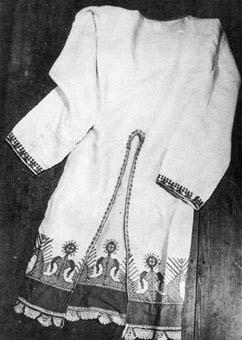
Real.
And now, like Vod not. Among the many old sayings Vodskaya one became prophetic: "The land and trees are, and we will not." People disappear in the eyes and care of people decreases to one-tenth. The answer to the question of nationality is always first is: "We are Russian." After the second question admit: "We Izhora". And only occasionally, after opinion agrees: "We Wadden." The middle generation hardly remembers, and the children did not know what they are - Vod.
A small nation Vod Finno-Ugric group is close to complete assimilation. Now the water is densely populated only in two villages - Krakolie and Lusatia Kingisepp district of Leningrad region. Votian listed as endangered languages of Russia.
Residents are concerned that the construction of Ust-Luga port may lead to the demolition of the village Krakolie and the village of Lusatia will be in the industrial zone. The destruction of places of compact residence of course means the final death Votic language and culture.
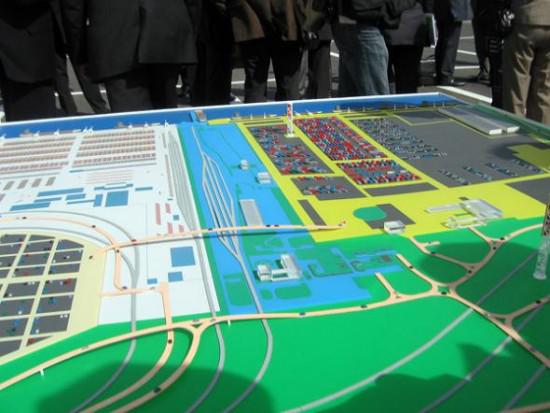
model port of Ust-Luga in 2020
The development plan provides for the resettlement of residents of the port, whose houses are in the buffer zone of the port.
Source:
My Thanks! Auto RU.
There are people, great for its history and culture, and there are people who have been great. There are peoples whose past and future exist, and there are people who have left just past. And speaking of Bodi, is to talk about the past ...

Ancient history.
Few people know that Vod, along with Izhora - the oldest known to us the people of the North-West of Russia. Historical information about Vod is very scarce and refer only to the period of the Middle Ages, though perhaps ancient reports of "Chud" relate to this small ethnic group. Since Vod lived on the outskirts of Novgorod possessions, Russian chronicles evade its history in silence, noticing only the most visible - a disaster and war.
Found sickles, scythes, and millstones in medieval cemeteries Vod say that the main occupation of the people already in those days was agriculture. It made it possible to keep nourishing life, but periodically imposes a heavy tribute - crop failures and famine. Annals of scarce emotions. But how terrible were the consequences of the famine in 1215, when the hand of a monk usually reserved subscribed to these news letters and jagged lines. People eat pine bark, lime leaves and moss. The poorest gave their children to others, so that at least they may be saved from starvation. Deaths were nadorogah, boxes and shopping areas - and they were so numerous that it was impossible to bury. "Vaujany pomrosha and ostanke razidesya».
Sources of Vod known from the second millennium since the people did not know writing. Carriers Culture letters were Slavs who appear on these lands in the IX-X centuries.
The appearance of the Slavs in the lands of Vod is primarily due to the fact that at the end of the XIII century on the Neva was laid Volga trade route, and along the rivers Luga and Mshage Shelon - second trade route.
The fertile soil of the Izhora Plateau has attracted a lot of Slavic immigrants who settled intermingled with the indigenous inhabitants.
At the beginning of the second millennium Vod was independent from Novgorod people. This is evidenced by the first mention in Russian written document - the charter of Yaroslav. The source said about the campaign in 1069 Polotsk prince Vseslav to Novgorod. His army largely consisted of Vozha River (Vod). The prince was defeated, lots Vozha River died.
In the first half of the XII century the influence of Novgorod increases. The interest of the Russian state is due primarily to the fact that Votskaya land (land Vod) was of great strategic importance. The presence of allied relations between vodyu and Novgorod confirmed the Novgorod First Chronicle. In 1149, the Finnish tribe Em went on a campaign Vod, but Novgorod helped detachment, numbering 500 soldiers. Allies routed the invaders, from which few escaped.
By this time the mention of the Novgorod region - fifths that make up the territory of the Novgorod state. One of fifths, located on the southern shore of the Gulf, ie Vod in the territory called Votskoy. Consequently, in the middle of the XII century Vod is part of Novgorod.
Since the second half of the XII century in the Baltic region appear powerful contenders for the land - Western Knights and begin a consistent winning. Between 1164 and 1181 years, held the bull (edict) Pope Alexander III to the Swedish Bishop Stefan. Swedish alleged impact on votlandtsev (Vod). This is the first mention of the Vod in foreign sources.

Pope Alexander III.
In 1202, militant Knights formed the Order of the Sword. Already in 1224 the invaders take possession of the ancient Russian city of Yuriev (Tartu). Now it is possible to direct threat Pskov and Novgorod principalities, especially that both countries plagued internal conflicts. In 1228, for example, concluded a treaty with the people of Pskov and the Order invited the German squad, which helped get rid of unwanted Prince Yaroslav. But the tireless Prince sat in Novgorod and made seven campaigns against the Germans, Lithuanians and Swedes.
Apparently, the Vod has a substantial military support to Novgorod, as in 1230, Pope Gregory IX had to prescribe a Swedish archbishop to forbid all Christians carry the Gentiles votlandtsam weapons, iron and wooden products, "That faith of Christ has not been Iskor Her enemies".
In 1237 followed by a new bull of the pope, in which he tells him to make an appeal for a crusade against the pagans and their allies Russian. But the people of Novgorod were on guard, and in 1239 they undertook to strengthen the border, build a fortress on Shelon and resuming relations with Vodskaya ground.
July 15, 1240, Prince Alexander breaks detachment Swedish knights, led by Birger in the Battle of the Neva. Perhaps, along with the Finnish tribe Izhora, in the Novgorod army detachment includes Vod.

This painting done by St. Petersburg artist Igor Zhebrovsky to be installed in the future museum dedicated to the Battle of the Neva.
A month later, a small German and Danish knights led by the Vice-Master of the Order Andreas von Velvenom launched a major offensive in the Pskov and Novgorod. In winter 1240/41's capture followed Vodskaya territory and the laying tribute. However, Alexander Nevsky already in 1241 unexpectedly knocks invaders from Koporye and frees Vodskaya ground. Those people from Vozha River, which obviously kept the German side, he orders to hang. April 5, 1242 a battle took place on Lake Peipsi, which was won glorious victory over the Order. But the German attack continued until 1269, when concerned about a successful campaign of the Russian troops, they are asking for the world.
In the second half of the century XIII Vod is likely finally a part of Novgorod lands already mentioned. The reason for consolidation is firmly and included in the life of the peoples of both social and economic ties, and the constant threat from neighbors. Noticeable influence of Russian culture reflected in the funeral rite Vodskaya, which serves as the major identifier. In the XIII century the rite of cremation in stone fences replaced inhumation in groundwater wells, although both types of graves for some time coexist.
External threats in the XIV century unabated. In 1338, the Swedes attacked from Vyborg Vodskaya ground. But the defense was well organized and so the Swedes, "nothing is not vzyasha" were soon defeated the garrison of the fortress was. In 1348 the Swedish King Magnus with a great army invaded the Novgorod possession and began to baptize Vozha River. Some of them submits, but other organized resistance that was crushed by death squads. Soon, however, the Swedes go and traitors of Votes, like a hundred years ago, were hanged Novgorod.
Fortress Yam.
1384 was marked by building on the ancestral lands Vod fortress. Novgorod "postavisha stone town on the river Luga - Pit (Yam Yamburg Kingisepp-current)", indicating that a strong Russian influence on Vod. In 1397, the German squad attacked Vodskaya Pyatina and devastated neighborhood Pit. In the first half of the XV century, followed by a new attack by the Germans. In the 20's Master of the Order Finn repeatedly invades the Novgorod possession, burns a hole and capture many prisoners in Vodskaya earth.
In the war years 1444-1448 the Germans, united with the Swedes, together attacked Votskuyu fifths. Mentioned Germans capture many prisoners Vod that steal the Baltics and lodge near Bauska. It is interesting that local people called them krevingami (krievs - Russian).
By 1478, when the merger took place of Novgorod to the Moscow government, it should be noted some aspects of people's Vod. Contacts between Russian and vodyu are vzaimokulturny character. Vaujany generally retain the traditional culture with the exception of the funeral rite, which borrow from the Russian. Due to the fact that members of the hard-working people Votic actively manifest themselves in agriculture, trade and craft increases the value of land Vodskaya to score exceptionally strong pace of economic development in the part of Russia.

Nasty molbischa idolskie.
For the first time about paganism Vod we learn from written at the end of the XII century the message of Pope Alexander III, the first bishop of the Swedish city of Uppsala Stefan. And though in 1255 these lands Rome was appointed Catholic Bishop, Vod officially considered Orthodox. But the roots of paganism of the people were very strong. After three centuries, in 1534, Archbishop Makarios notified Novgorod Grand Duke Ivan that Vodskaya pyatina there are many idolatrous superstition, and that local people are still "bad molbischa idolskie." Pagans buried their dead not churchyard and on the mounds and "kolomischam" (from obschefinskogo word "Calma" - "world of the dead"), to the newborn called "Arbois" (priests). Vodskaya woman after marriage, shaved their heads and wore "deathly" clothing. Grand Duke ordered the "rotten ONU to eradicate": prayer grounds were destroyed, were cut and burned the sacred groves and trees, dumped into the water sacred stones, koldunov- "Arbois" sent to Novgorod to crack.

Ivan Vasilyevich (Ivan IV the Terrible)
But it is hard to find among the peoples of the North-West Russian population more fully keep their ancient beliefs and practices than Vod. Back in the mid-twentieth century Vaujany still worshiped the old trees, huge rocks, springs and wells. Even twenty years ago, arrived in Votic villages could get into a mysterious and forbidden world where everything was animate. Home and family defended the house, a guardian spirit was and livestock. Domestic spirits often approached people in the form of snakes - that is why snakes have always loved and lure. In the forest, has hosted the devil. His spirits had every rock, tree and flower. Spirits live in rivers, streams and swamps. To defend against them, you need to know hundreds of plots to come to terms with them, it was necessary to make sacrifices.
The shape and nature of Vozha River.
At first glance it is difficult to distinguish Vozha River among other Baltic and Finnish peoples. There are, however, two features have Vozha River. First, representatives of Vod only fair haired. Perhaps it was the fair-haired people in the world: 80% of men and 76% women's hair were white as snow turned yellow or golden like the sand.
We can not ignore another aspect of the external appearance of Votes, which is recognized by all the main, though it defies precise measurement. This is a beauty. At the end of the XVIII century a remarkable scholar of indigenous peoples Fedor Tumansky wrote: "Women chyudskie (Votic - DC) in general all are beautiful, have a cheerful, pleasant and attractive look, quick eyes, big blue ... they are of good growth, the hair almost all light-brown, have a healthy body, a gentle, white and clean ».
A famous Finnish historian portal regretfully admitted that women are much prettier Votic Finnish and Russian. Immediately struck by the nature and features: Vaujany seemed faster, lively and open towards other people than representatives of neighboring nations. In the XVIII century witnesses to notice such features Vozha River as "a very sharp mind, an early concept».
This natural alertness and manifest in language. Vodskaya speech was very lively. It is no accident at all was the answer to the riddle Vodskaya "Gudit-cracking the golden lock" (language). And the residents of the village on the river Luga Kurovitsy sometimes advised each other: "Tie language to your ear to talk less."
Votian.

Votic language belongs to the Baltic-Finnish group of the Ural family of languages. Votian represented by several local dialects, which are usually divided into western and eastern. Among Western dialect etc. can be identified. Krokole close to him dialect villages Lusatia (Luutsa) and Sands (Liivcyla), dialects of the villages in the vicinity d Mattia (Mati), dialects of the villages in the vicinity d. Boilers (Kattila) and Dialects are sub- Boilers. To East Vodskaya dialects are several villages in the area Koporye (Kabrio). The difference between West and East Vodskaya Vodskaya dialects small.
By Votian traditionally carry two dialects, with significant differences from the above. This dialect krevingov, descendants Vodskaya prisoners resettled near Bauska Livonian knights in the middle. 15 in., And the dialect d. Kurovitsy (Kukkuzi), resulting from the "izhorizatsii" local Votian.
According to Paul Ariste (Estonian linguist) Vodskaya impact noted in some north-eastern dialects of Estonia and in some dialects in the Estonian shore of Lake Peipsi.
Vodskaya impact significantly in a number of Finnish dialects of Western Ingria.
Some researchers also mention the existence of a Baltic-Finnish near Gdov, Dobruchinskaya parish.
The first grammar Votian appeared in the 19th century (Alkvist). In the early 20th century, Dmitry Tsvetkov from the village. Krakolie Vodskaya wrote the first grammar of their native language. In the 30-ies., When creating scripts for minority languages to Votian not created a separate writing and learning in schools conducted at the Izhora language. Stalinist repression and Second World War caused great damage Vodskaya people. After the war, not all Vaujany was able to return to their villages. In schools in the postwar period teaching it was only in Russian, and the use of Votian not encouraged even in person. This has resulted in a sharp reduction in the spread of the territory Votian the end of the 20th century.
Nevertheless, since the beginning of the 90s. It begins a movement to revive Votian and in 1994 are beginning to function Votian courses in St. Petersburg. With the advent of the 21st century the activities of these courses is activated. At the same time begins the first time the teaching Votian high school d. Krakolie. Currently, work is underway to create a different kind of training manuals Votian.
Teach Votian (2.86 MB).
Clothing Vod.
Allocates Vod and unusual his clothes: without question you can immediately identify who walked past - a girl, pullets, older women or old.
Beautiful, but she was restrained maiden costume, it combined the two main colors - white and red. White hair and white clothes were supplemented by two red woolen bib crescent-shaped and the two red Gaiters' kaatyryd "hanging on the sides of the back. Adults girls their loose hair covered small cap incredibly beautiful, entirely embroidered with beads and bright tin plaques.

Votic costume of the late 18th century.
When a woman marries, her costume became bright and elegant. Her sundress was blue, it was put on top of the second, also the blue apron. These aprons and white shirt decorated with complicated multi-color embroidery, beads, pearls, semi-precious stones. Married woman shaved her head to kind of guardian spirits of the bride, always hostile to old groom may not go along with the bride in her husband's house. This rite echoes existed in many European and Asian nations, and in Vod he lived to the beginning of XX century. Shaved head crowned with a white complex high headdress.
festive men's coat Vod.
When a woman acquires a child, her headdress turns red and the clothes - almost no decorations. 10-15 years (sometimes at the request of her husband) wore clothes vozhanki old women - white long shirt and complex polotenchaty headdress. But the aprons, hip, all sorts of jewelry to wear "Vanha (old) woman," had no right to.

Real.
And now, like Vod not. Among the many old sayings Vodskaya one became prophetic: "The land and trees are, and we will not." People disappear in the eyes and care of people decreases to one-tenth. The answer to the question of nationality is always first is: "We are Russian." After the second question admit: "We Izhora". And only occasionally, after opinion agrees: "We Wadden." The middle generation hardly remembers, and the children did not know what they are - Vod.
A small nation Vod Finno-Ugric group is close to complete assimilation. Now the water is densely populated only in two villages - Krakolie and Lusatia Kingisepp district of Leningrad region. Votian listed as endangered languages of Russia.
Residents are concerned that the construction of Ust-Luga port may lead to the demolition of the village Krakolie and the village of Lusatia will be in the industrial zone. The destruction of places of compact residence of course means the final death Votic language and culture.

model port of Ust-Luga in 2020
The development plan provides for the resettlement of residents of the port, whose houses are in the buffer zone of the port.
Source:


